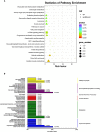Physiological Effects and Transcriptomic Analysis of sbGnRH on the Liver in Pompano (Trachinotus ovatus)
- PMID: 35586618
- PMCID: PMC9108241
- DOI: 10.3389/fendo.2022.869021
Physiological Effects and Transcriptomic Analysis of sbGnRH on the Liver in Pompano (Trachinotus ovatus)
Abstract
Pompano (Trachinotus ovatus) is one of the important economic marine fishes in the south coast of China. At present, the research on the basic biology of pompano is relatively weak, which has seriously affected the development of this economic important fish. The liver is an important digestive and metabolic organ of fish which plays an important regulatory role in its growth and development. It is necessary to clarify the effects of sea bream gonadotropin releasing hormone (sbGnRH) on liver physiology and metabolic enzyme activity. The effects of sbGnRH peptides (10 ng/gbw) on the physiological and biochemical indices and metabolic enzyme activities of pompano liver were studied. It was found that after injection of 10 ng/gbw sbGnRH peptides, the contents of albumin, high-density lipoprotein cholesterol, low-density lipoprotein cholesterol, glucose, creatine kinase, iron, magnesium, aspartate aminotransferase, alanine aminotransferase and creatinine increased, while of cholesterol and calcium contents decreased. The activities of amylase, lipase, pyruvate kinase, acyl CoA oxidase, superoxide dismutase, phospholipid hydroperoxide glutathione peroxidase, catalase, glucose-6-phosphate dehydrogenase, fatty acid synthase and lipoprotein lipase increased, while the activities of malic enzyme, carnitine acyl, carnitine translocation, acetyl CoA carboxylase and malondialdehyde decreased. Three hours after the injection of different concentrations of sbGnRH peptides (0 and 10 ng/gbw), the transcriptome sequences of the two groups of livers were sequenced. After quality control and removal of some low-quality data, clean reads of 21,283,647、19,427,359、21,873,990、21,732,174、23,660,062 and 21,592,338 were obtained respectively. In this study, 99 genes were screened and identified as differentially expressed genes, including 77 up-regulated genes and 22 down-regulated genes. According to the Kyoto Encyclopedia of Genes and Genomes (KEGG) and Gene Ontology (GO) pathway analyses, these pathways and the typical genes involved can be divided into cellular processes, environmental information processing, genetic information processing, diseases, metabolism and organismal systems. The results from this study provide a the oretical basis for studying the effects of sbGnRH on the physiology, biochemistry and metabolic enzyme activities of liver in pompano.
Keywords: Trachinotus ovatus; liver; physiology; sbGnRH; transcriptome.
Copyright © 2022 Ren, Liu, Ndandala, Li, Guo, Li and Chen.
Conflict of interest statement
Author JL is employed by Guangdong Havwii agricultural Group Co., LTD. The remaining authors declare that the research was conducted in the absence of any commercial or financial relationships that could be construed as a potential conflict of interest.
Figures







Similar articles
-
Identification and functional characterization of gonadotropin -releasing hormone in pompano (Trachinotus ovatus).Gen Comp Endocrinol. 2022 Jan 15;316:113958. doi: 10.1016/j.ygcen.2021.113958. Epub 2021 Nov 30. Gen Comp Endocrinol. 2022. PMID: 34861278
-
Skin transcriptomic analysis and immune-related gene expression of golden pompano (Trachinotus ovatus) after Amyloodinium ocellatum infection.Fish Shellfish Immunol. 2022 Sep;128:188-195. doi: 10.1016/j.fsi.2022.07.052. Epub 2022 Jul 20. Fish Shellfish Immunol. 2022. PMID: 35870749
-
Dietary calcium pyruvate could improve growth performance and reduce excessive lipid deposition in juvenile golden pompano (Trachinotus ovatus) fed a high fat diet.Fish Physiol Biochem. 2022 Jun;48(3):555-570. doi: 10.1007/s10695-022-01077-1. Epub 2022 Apr 23. Fish Physiol Biochem. 2022. PMID: 35461391
-
Metabolic dysregulation and emerging therapeutical targets for hepatocellular carcinoma.Acta Pharm Sin B. 2022 Feb;12(2):558-580. doi: 10.1016/j.apsb.2021.09.019. Epub 2021 Sep 25. Acta Pharm Sin B. 2022. PMID: 35256934 Free PMC article. Review.
-
Regulation of energy metabolism by long-chain fatty acids.Prog Lipid Res. 2014 Jan;53:124-44. doi: 10.1016/j.plipres.2013.12.001. Epub 2013 Dec 18. Prog Lipid Res. 2014. PMID: 24362249 Review.
Cited by
-
Integrated transcriptome and metabolome analysis of liver reveals unsynchronized growth mechanisms in blunt-snout bream (Megalobrama amblycephala).BMC Genomics. 2025 Jan 13;26(1):30. doi: 10.1186/s12864-025-11208-6. BMC Genomics. 2025. PMID: 39806290 Free PMC article.
-
Identification of Insulin-like Growth Factor (IGF) Family Genes in the Golden Pompano, Trachinotus ovatus: Molecular Cloning, Characterization and Gene Expression.Int J Mol Sci. 2024 Feb 21;25(5):2499. doi: 10.3390/ijms25052499. Int J Mol Sci. 2024. PMID: 38473747 Free PMC article.
References
Publication types
MeSH terms
Substances
LinkOut - more resources
Full Text Sources

